Native plants to the rescue - help a Monarch!
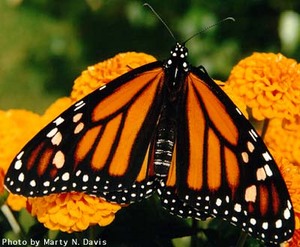
Monarch butterfly, taking a rest
Photo by Marty N. Davis, MonarchWatch.org
This change will continue to reduce the numbers of milkweed plants available for Monarchs, which are milkweed specialists. If you do want to read the article I read in USA Today, here is the link to it .
There are many, many beautiful and interesting butterflies and moths, but for me the Monarch is special. Perhaps it’s my association of them with Lake Michigan beaches in the summer. Perhaps it’s their cool-looking caterpillars. I don’t know, but whatever the reason, they are butterflies I want to keep around.
If you want to help their chances of survival, while beautifying your yard and creating some winter interest as well, I suggest planting a bed or two of milkweeds in your yard. There are many species of them, with different flower colors and shapes and preferred growing conditions. There are four species that are commercially available from local native plant vendors. You may luck out and have caterpillars, but you’re almost assured to have an occasional Monarch float in to dine on the flowers’ nectar.
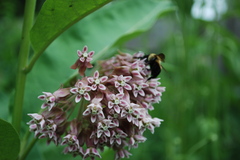
Common milkweed (Asclepias syriaca) with a visitor
Rick Meader|Contributor
Common milkweed (Asclepias syriaca), is probably the milkweed you’re most familiar with. It grows to about three to four feet high, has a large cluster of pinkish/mauvish flowers and has large, tear-drop shaped seed pods that burst open to release many, many seeds on parachutes, which float in the wind to spread their range. Common milkweed is usually found in mesic to somewhat dry situations. (A note to parents: This is a great activity for kids. Wait until the pod is dry and opening on its own. When the pod is open, kids love to pull out the seeds and release them into the wind, either natural or provided by them. This goes for other milkweed species too.)
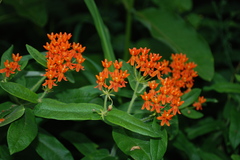
Butterfly milkweed (Asclepias tuberosa) in bloom
Rick Meader|Contributor
Butterfly milkweed (Asclepias tuberosa) is the bright orange plant you see in summer, often standing alone in a dry meadow, or along the side of a highway. This plant prefers drier conditions, and seems to do better in poor soils than many other plants. This plant usually only grows to two to three feet high and has clusters of bright orange flowers that are also popular with butterflies (not just Monarchs).
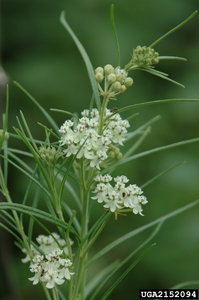
Whorled milkweed (Asclepias verticillata)
Photo by Chris Evans, River to River CWMA, Bugwood.org
Whorled milkweed (Asclepias verticillata) is not as well known to most of us, but is apparently a real crowd-pleaser among butterflies. It is a short plant, only growing to about two feet tall and has much thinner leaves than the other milkweeds covered in this entry. It has little white flowers and very thin, almost strap-like leaves. This plant thrives in dry to medium dry conditions. It's also a nice, smaller plant than some others can be, due to its height and character, but, according to one account, given the right conditions can quickly form a large colony.
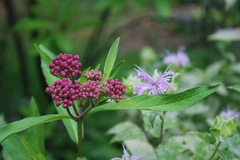
Swamp milkweed (Asclepias incarnata) with Wild Bergamot (Monarda fistulosa)
Rick Meader|Contributor
If you love Monarchs, you may want to visit the Monarch Watch Web site, a local Monarch Web site or the "My Monarch Guide" Web site. If you can join in with your neighbors to plant some of these beautiful, and useful, milkweed plants, you could help to counter some of the negative factors facing Monarchs and other butterflies, add some color and diversity to your flower beds and perhaps create a new breeding ground for butterflies that will dazzle you and your friends.
As I mentioned, the species covered above are commercially available. The Michigan Native Plant Producers Association is a group of nurseries devoted to selling plants native to Michigan. We are fortunate to have two excellent nurseries within a short driving distance of Ann Arbor. One, located here in Ann Arbor, is Native Plant Nursery. Greg Vaclavek has a booth at the Ann Arbor Farmer’s Market every Saturday during the growing season where you can buy these native plants and many more, and learn a ton in the process.
Another great native plant nursery is Wildtype Native Plant Nursery, located in Mason. Bill Schneider owns Wildtype and is always happy to answer any questions about plants you see on his Web site and at his nursery. Both Bill and Greg have in-depth, firsthand knowledge of the plants they carry as they gather the seeds from the wild themselves, and have seen them used in a variety of landscape situations as well.
Many times in life we see a tough situation and lament that we can’t do anything about it. Well, in this case you can - and get great benefits for yourself in the process. So, plan to plant some milkweed this year, encourage your friends and neighbors to do the same and enjoy the nature in your yard!
Rick is a local landscape architect with a special interest in all things natural, including native plants and the critters that eat them. You can contact him at yourland1824@gmail.com.


Comments
Dante Marcos
Wed, Apr 14, 2010 : 8:20 a.m.
Thanks for this wonderful piece. For swamp milkweed, you need only visit Greg Vaclavek at the AA Farmers Market, beginning in May, for plugs. And butterfly milkweedjust a few stalls away, at the Farmers Marketis often sold by Kathy Melmoth. Both flourish in my garden, and Monarchs love them. They also feast on butterfly bush, which is not a native plant, and is rangy, gangly, unkempt, but with gorgeous flowers.
Epengar
Tue, Apr 13, 2010 : 4:35 p.m.
More information on landscaping with native plants, from our own Natural Area Preservation unit: http://www.a2gov.org/government/publicservices/fieldoperations/NAP/NativePlants/Pages/NativePlants.aspx
Rork Kuick
Tue, Apr 13, 2010 : 1:08 p.m.
Excellent article. I never thought to try swamp milkweed in the yard, though I admire it often in the wild. Butterfly milkweed is my favorite - what a tough plant, it waits forever to start growing in spring, instead using the baking days. Careful study of pollination tricks of milkweeds is rewarding - put them under the lens. Note the similarity to Hoya, you indoor plant growers. Taste nectar (after study perhaps). While working for the state DNR with other botany nuts 2 years ago, we came across a green-flowered milkweed in a dry sandy area that stumped us at the time, even though we had several field guides with us. I think it was green comet milkweed (Asclepias viridiflora). The lesson: not every flower in our area is in the popular field guides, even if it's fairly cool. That's may sound sad for botany fans, but it is really a testament to our riches. Lots of chances to volunteer out there in the parks this spring. Killing garlic mustard is a common activity, and around earth day one often gets bigger crowds. No prisoners! http://www.stewardshipnetworkonline.org/ lists opportunities. The Pinckney recreation area work day this Sunday is at the place with the funny green milkweed (and many other jewels).